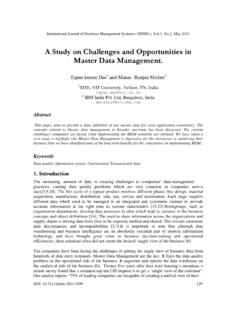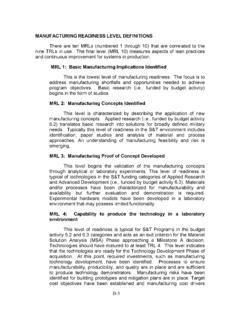Transcription of The future of food and agriculture – Trends and challenges ...
1 summary VERSION1 The futureof food andagriculture Trends and challengesThe designations employed and the presentation of material in this information product do not imply the expression of any opinion whatsoever on the part of the Food and agriculture Organization of the United Nations (FAO) concerning the legal or development status of any country, territory, city or area or of its authorities, or concerning the delimitation of its frontiers or boundaries. The mention of specific companies or products of manufacturers, whether or not these have been patented, does not imply that these have been endorsed or recommended by FAO in preference to others of a similar nature that are not views expressed in this information product are those of the author(s) and do not necessarily reflect the views or policies of FAO.
2 FAO, 2017 FAO encourages the use, reproduction and dissemination of material in this information product. Except where otherwise indicated, material may be copied, downloaded and printed for private study, research and teaching purposes, or for use in non-commercial products or services, provided that appropriate acknowledgement of FAO as the source and copyright holder is given and that FAO s endorsement of users views, products or services is not implied in any requests for translation and adaptation rights, and for resale and other commercial use rights should be made via or addressed to information products are available on the FAO website ( ) and can be purchased through VERSIONThe futureof food andagriculture Trends and challengesFOREWORD 4 CAUSE FOR HOPE AND CONCERN 6 Trends 81 Population growth, urbanization and ageing 92 Global economic growth, investment, trade and food prices 103 Competition for natural resources 154 Climate change 175 Agricultural productivity and innovation 206 Transboundary pests and diseases 227 Conflicts, crises and natural disasters 248 Poverty.
3 Inequality and food insecurity 269 Nutrition and health 2910 Structural change and employment 3211 Migration and agriculture 3412 Changing food systems 3613 Food losses and waste 3914 Governance for food and nutrition security 4115 Development finance 42 This booklet summarizes key messages from the report The future of Food and agriculture - Trends and challenges . The figures and graphs are taken from that future OF FOOD AND agriculture Trends and challenges challenges 441 Sustainably improve agricultural productivity to meet increasing demand 2 Ensure a sustainable natural resource base 3 Address climate change and intensification of natural hazards 4 Prevent transboundary pests and diseases 5 Eradicate extreme poverty and reduce inequality 6 End hunger and all forms of malnutrition 7 Improve income-earning opportunities in rural areas and address the root causes of migration 8 Build resilience to protracted crises, disasters and conflicts 9 Make food systems more efficient.
4 Inclusive and resilient 10 Meet the need for coherent and effective national and international governance | 4 |FAO s v i sion is of a world free from hunger and malnutrition, where food and agriculture contribute to improving the living standards of all, especially the poorest, in an economically, socially and environmentally sustainable manner . To help its Members realize that shared vision individually at the national level and collectively at the regional and global levels FAO organizes its work taking account of the main challenges facing the food and agriculture sector. The present study, which was undertaken for the quadrennial review of FAO s Strategic Framework and preparation of the Organization s Medium-Term Plan, 2018 21, lays out key global Trends and challenges that will inf luence food and agriculture in the coming Trends and challenges analysed here are cause for both hope and concern.
5 Much progress has been made in reducing hunger and poverty and improving food security and nutrition. Gains in productivity and technological advances have contributed to more efficient resource use and improved food safety. But major concerns persist. Some 795 million people still suffer from hunger, and more than two billion from micronutrient deficiencies or forms of overnourishment. In addition, global food security could be in jeopardy due to climate change and mounting pressure on natural resources, both of which threaten the sustainability of food systems at large. Planetary boundaries may well be surpassed, if current Trends continue. Our assessment of prevailing Trends suggests, therefore, that in order to realize FAO s vision, transformative changes in agriculture and food systems are required worldwide.
6 In FAO s view, there are 10 key challenges that need to be addressed if we are to succeed in FOREWORDTHE future OF FOOD AND agriculture Trends and challenges | 5 |eradicating hunger and poverty, while making agriculture and food systems sustainable. Those challenges include the uneven demographic expansion that will take place in the coming decades, the threats posed by climate change, the intensification of natural disasters and upsurges in transboundary pests and diseases, and the need to adjust to major changes taking place in global food systems. We welcome the growing attention that the international community is paying to these concerns. Overall, Trends and issues in 2015-2016 have spurred the global community into action through a series of initiatives and agreements, which reset the global development agenda.
7 These developments constitute the global context for FAO s work in the future , under the overall umbrella of the 2030 Agenda for Sustainable Development and the Sustainable Development Goals (SDGs), and include the Addis Ababa Action Agenda, the Paris Agreement on climate change, the World Humanitarian Summit and the United Nations Secretary-General s Agenda for purpose of this report is to help mobilize the concrete and concerted actions required to realize these global agendas. It contributes to a common understanding of the major long-term Trends and challenges that will determine the future of food security and nutrition, rural poverty, the efficiency of food systems, and the sustainability and resilience of rural livelihoods, agricultural systems and their natural resource Graziano da Silva FAO Director-GeneralTHE future OF FOOD AND agriculture Trends and challenges | 6 |Over the past century, enormous progress has been made in improving human welfare worldwide.
8 Societies have changed radically thanks to quantum leaps in technology, rapid urbanization, and innovations in production systems. Yet conditions today are a far cry from the world free of fear and want envisioned by the founders of the United Nations. In fact, much remains to be done to fulfil the vision of the Food and agriculture Organization of the United Nations (FAO), which is to create a world free of hunger and malnutrition and one in which food and agriculture contribute to improving the living standards of all, especially the poorest, in an economically, socially and environmentally sustainable manner .Amid great plenty, billions of people still face pervasive poverty, gross inequalities, joblessness, environmental degradation, disease and deprivation. Displacement and migratory flows are at their highest levels since the Second World War.
9 While many armed conflicts have been resolved, new ones have emerged. Much of humanity s progress has come at a considerable cost to the environment. The impacts Global Trends and challenges that are shaping the future of food and agriculture :Cause for hope and concernINTRODUCTIONTHE future OF FOOD AND agriculture Trends and challenges | 7 |of climate change are already being felt, and if left unabated will intensify considerably in the years ahead. Globally integrated production processes have brought many benefits. However, challenges in regulating those processes highlight the need to steer them towards more equitable and sustainable global Trends influence food security and the overall sustainability of food and agricultural systems, they give rise to a number of questions.
10 Are today s food and agricultural systems capable of meeting the needs of a global population that is projected to reach more than nine billion by mid-century? Can we achieve the required production increases, even if this implies adding pressure to already dwindling land and water resources, and do so in a context of climate change? The future of food and agriculture Trends and challenges , tries to answer these questions, laying out and analysing key global Trends that are influencing and will influence food and agriculture in the coming decades, together with the associated challenges to face ahead. THE future OF FOOD AND agriculture Trends and challenges | 8 | Trends : Major drivers of change in the 21st centuryTHE future OF FOOD AND agriculture Trends and challenges | 9 |TREND 1 Global population growth is slowing, but Africa and Asia will still see a large population dynamics will radically change demographics over the coming decades and towards the end of the century.
















